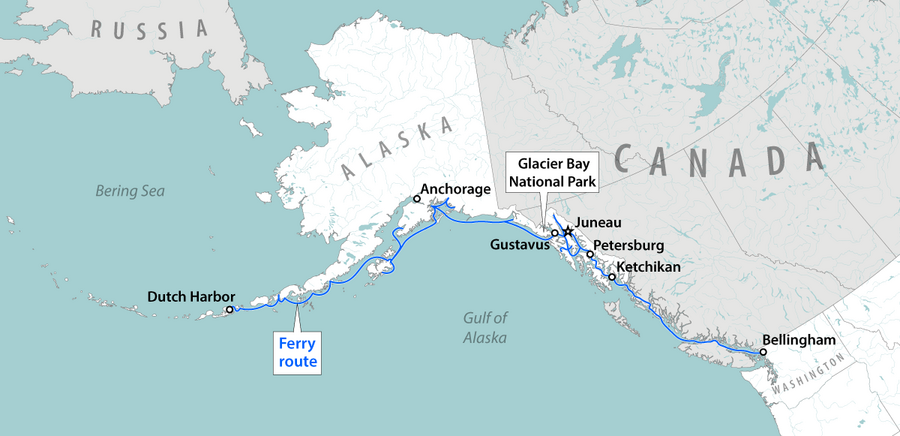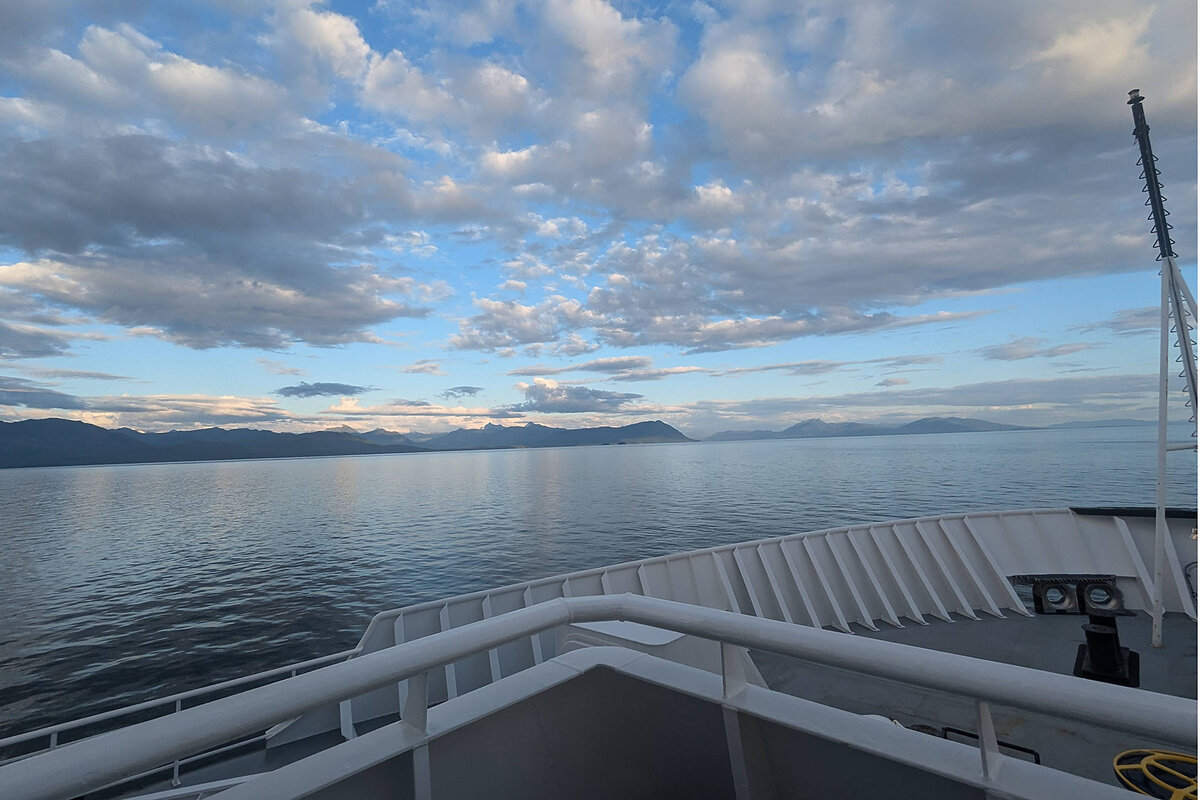The ‘other’ Alaska cruise: Got a week? Pitch your tent on deck.
Loading...
| Juneau to Petersburg, Alaska
Framed by snowcapped mountains and forest-blanketed islands, the MV Kennicott glides into Auke Bay on the outskirts of Juneau with little fanfare. It’s two hours late, but the passengers lining up to board aren’t overly concerned. No one who buys a ferry ticket on the Alaska Marine Highway System is in a hurry.
The Kennicott – a 382-foot-long vessel with sleeping cabins, observation lounges, and a heated solarium deck – belongs to a fleet of publicly owned ships plying the 3,500-mile crescent of archipelagoes along the southern Alaska coast. They connect people and vehicles to 30 remote, ferry-dependent Alaskan towns; some operate year-round.
The Kennicott is a fraction of the size of the ships of the booming Alaska cruise industry that dock in downtown Juneau. And it’s far less expensive. But it traverses similar terrain and offers front-row views of the vast, rugged landscape that defines the 49th state.
Why We Wrote This
A story focused onIn the shadow of luxury cruise liners, the humble Alaska Marine Highway System wends through the Inside Passage connecting remote communities while helping tourists disconnect.
The catch? Bring your own ... everything.
“It’s entirely DIY,” says Jennie Flaming, host of the podcast “Alaska Uncovered.” Dining is limited to vending machines and a self-serve cafeteria. Towels and bedding are extra. There’s no Wi-Fi, so passengers entertain themselves with games, puzzles, and books. Some bring sleeping bags or set up tents and hammocks in the solarium and upper decks. (Pro tip: Pack duct tape in case the winds pick up.)
A critical connector
Still, the ferries remain as meaningful to many Alaskans as the state glaciers after which each is named. Established in the 1960s by a state bond measure, the Alaska Marine Highway System is the only marine route recognized as a National Scenic Byway and All-American Road. Its stops include Gustavus, near Glacier Bay National Park, and (summer only) Dutch Harbor, a crab fishing hub in the Aleutian Islands.
“The ferries are our trains,” notes David Kiffer, mayor of Ketchikan, a port and cruise ship destination along the Kennicott’s route. “They are the blue highways that connect us, and without them we could not exist as a cohesive region.”
High school teams once used them to travel to sports tournaments and debate competitions. Residents of remote coastal areas hopped on to visit family and access services in other towns, or to travel to Canada and the Lower 48. They can bring their cars and pets.
Ferry ridership has declined sharply, from 400,000 in 1994 to 180,000 last year. In contrast, Juneau alone drew 1.7 million luxury cruise ship passengers in 2023.
Ferry schedules are “complicated and weird,” notes Ms. Flaming. “It doesn’t really work to hop on and hop off unless you have several weeks for your trip.”
Some of the vessels are pushing 50 years old, and require expensive repairs and lengthy periods off the water. Earlier this month, the Federal Transit Administration awarded the ferry system $177 million for improvements. Republican Sen. Lisa Murkowski, who recalls riding the ferry out of Ketchikan as a kid, backed the award, which will help replace one of the original vessels with a hybrid-powered ferry.
Pitching tents and staking out board games
Outside the Auke Bay Ferry Terminal, on a 65-degree summer day, my husband, son, and I line up behind a man in a baseball cap balancing Costco-sized boxes of chips and popcorn atop a hard-shell suitcase. He’s headed 200 miles south to Ketchikan, where he’ll catch an interisland ferry to Prince of Wales Island with his wife and preteen daughter to camp and catch enough halibut to last the winter.
Nearby, a scarlet-haired teacher from Pennsylvania is capping off visits to Denali and Glacier Bay National parks by taking the Kennicott to Bellingham, Washington. It’s a 77-hour, 830-mile journey that might make a less adventurous traveler impatient, but she’s bubbling with a first-timer’s enthusiasm, ready to pitch her tent.
My family is bound for Petersburg, a commercial fishing hub on Mitkof Island, where our older son spent the summer working on a trails crew. The ferry trip is eight hours, versus 30 minutes by commercial plane. We’re prepared for – and even giddy about – the slow pace.
We settle into a booth with books, magazines, and that rare sense of freedom triggered by a total disconnect from technology. The high-backed chairs have seen better days, but are nap-friendly. Other passengers beeline toward tables and help themselves to puzzles and games provided by the ship.
As the vessel leaves the harbor, we venture onto the blustery deck and watch Auke Bay and the Mendenhall Glacier recede from view.
The similarities with a cross-country Amtrak trip become clear: the first-come, first-served observation lounges; the coexistence of characters from all walks of life; the “lucky me” feeling as we witness stunning scenery impossible to see by car.
We learned about the Alaska ferry, as many non-Alaskans do, through friends. They’d sailed the MV Columbia between Juneau and Bellingham more than a decade ago and gushed about the experience as weird, wonderful, and truly Alaskan. They recalled daily ranger talks on whales and salmon, a dining room with fresh Alaska seafood, linens in every stateroom.
Mayor Kiffer, for his part, still rides the ferries with the hope that the system will someday return to its glory days. His preferred itinerary includes a stateroom, a good book, and plenty of time to watch the scenery roll by.
“Sometimes I just take the ferry from Ketchikan to Skagway and back, and I never even get off,” he says. “It takes three days and I am truly in my happy place.”








